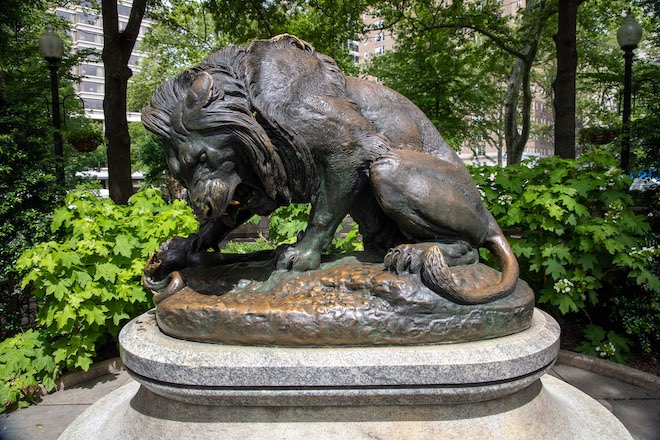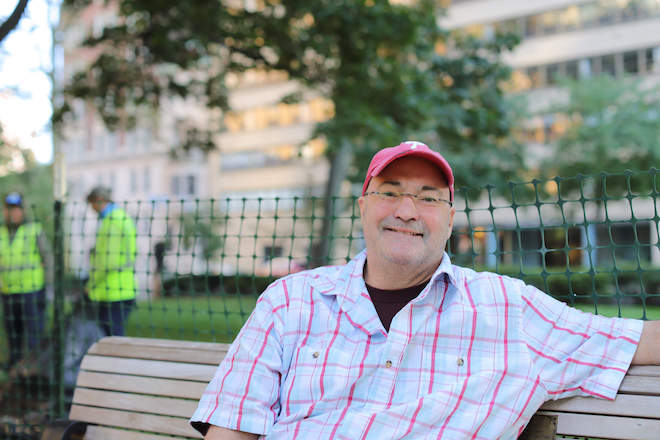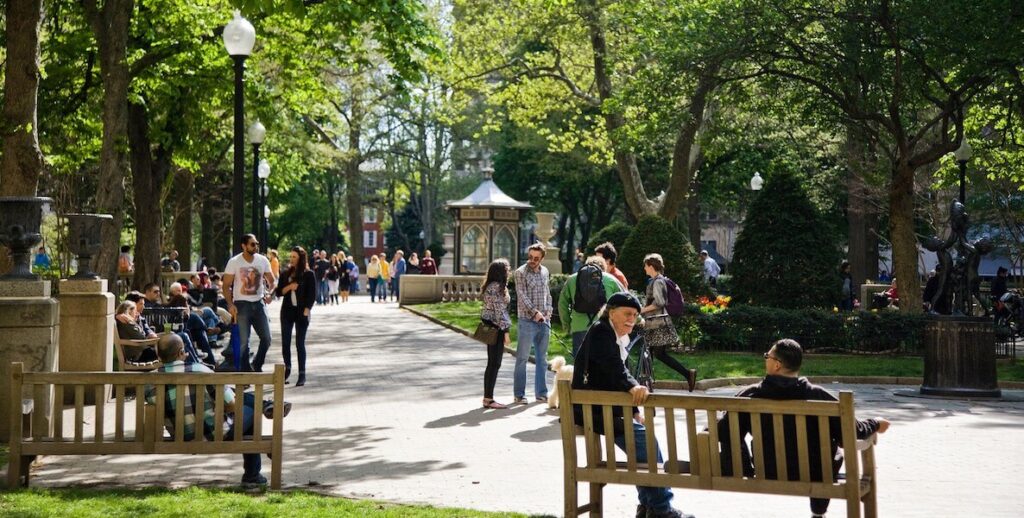There might be no person alive who knows New York City’s Central Park — or historic urban parks in general — as well as Doug Blonsky, who spent 33 years working for that park’s Conservancy, first as a landscape architect and later as president and CEO of the whole park.
When he first took the job in 1985, Central Park was not, as The New York Times once noted in a story about Blonsky, the “urban Eden” we know now. It was, in fact, in shambles — empty, barren, infamously crime-ridden. Under Blonsky’s leadership, the park saw hundreds of restoration projects, an entirely new scope of management and maintenance, transformative beautification and fundraising. (How much fundraising? Blonsky secured some $1 billion dollars during his tenure.) In short: The Central Park we all know today is Doug Blonsky’s Central Park.

In 2018, Blonsky retired and moved to Philly, where he currently resides with his wife, Mai, next to one of our urban Edens, Rittenhouse Square. (“Being able to look out my window every day now at this is pretty special,” he says.) Today, the ex-park honcho still spends much of his time immersed in ever more park beautification and maintenance — though this time, he does it for free as an unusually well-versed, expert volunteer with the Friends of Rittenhouse Square.
Given next week’s return of the vaunted black-tie Ball on the Square fundraiser for the park, it seemed like an excellent moment to catch up with Blonsky, who is the group’s vice president of operations, as well as the head of Friends’ operations, June Armstrong, to talk, yes, about fundraising and the Ball, but also about what challenges a park-like Rittenhouse Square faces in Philadelphia (you might be surprised), the park’s popularity, and why more trash cans isn’t always better.
This interview has been edited and condensed for clarity.

Christine Speer Lejeune: After all those years in New York — and at one of the most preeminent urban parks in the world — you’ve retired to Philadelphia and live on Rittenhouse Square. Why here?
Doug Blonsky: Well, I could have never afforded a park view in New York.
Ha.
DB: The similarities to Central Park are just amazing. One is obviously much bigger — 843 acres to just around seven. But when Central Park was built, it was the first time citizens of any class could get together and walk in the park. Rittenhouse Square is very similar — a place where everyone comes together. And after 35 years in New York, my wife and I said, “Let’s do something fresh.” Every year we’d go to Philadelphia just to get a hotel and enjoy it — and quite frankly, the food’s better in Philly than New York City.
That’s on record!
DB: My wife went to Temple for a semester and to Penn State for college. Her family lives in State College, and she’s got a lot of Pennsylvania in her blood. And it was just time for a change. I always said I’d do the Central Park job as long as I loved it every day. And I truly did. I worked seven days a week. I lived at that park. It was great to do something new.
Seems like you’re at this park a lot, too — you even have your own bench, dedicated to you and your wife, Mai, from the former Chairman at the Central Park Conservancy.
DB: I go every day I’m in town. June and I — and other Friends of Rittenhouse — meet a couple of times a week and sit on the bench for coffee. It’s nice office hours.
Speaking of the Central Park job, and the transformation you helmed … it’s almost unbelievable. In the 1980s, the place was — notoriously — a dump. At best. It’s not comparable, obviously, to what you’ve come into at Rittenhouse Square, which is beautiful. But Central Park is still a good story with a good lesson.
DB: I think we realized quickly that it’s pretty simple. You’ve got to make it clean, green and beautiful. When I started, we had 12 million visitors a year. When I left, it was 40 million visitors a year. You keep it beautiful, you get rid of the graffiti within 24 hours — and you’ve got to do all that stuff — and the positive wants to be there and the negative doesn’t want to be there. It absolutely works. When I started working there, we literally would have a thousand major crimes in Central Park every year. When I left in 2018, we were down to only about 50 crimes.
I remember my staff asking some dog owners, “Hey, could you please leash your dog up?” And people say, “No, I pay your salary; get outta here.” But they don’t.
That’s truly amazing. Also, I’m curious now if you know how many visitors Rittenhouse gets.
DB: We think about 10,000 people a day.
That’s a lot of people using that park.
June Armstrong: One of the things that Rittenhouse Square always has is a lot of people in it during the day. And over the last couple of years, we’ve worked to improve maintenance, upkeep, cleanliness. The bench replacement project was really big. A lot of the ones that were taken out of the park last year had almost fallen apart. Before Doug came on board, we actually had 96 overflowing trash cans every day.
Well, it is Philly.
DB: When I first walked through, I said, “‘Why the hell do you have a garbage can every 100 feet? You got to take some of these out. You can’t empty 96 cans every day.” Guy I was walking with said, “Nope, can’t be done. Philadelphians want their garbage cans.” But then, June went out and took out more than half of them, and no one complained. And it changed the aesthetic immensely.
JA: Now there are 29. And not as much trash in the park.
DB: As long as it’s with eyesight or at an entrance, that’s all you need. And it didn’t cost a damn thing. In fact, it saves you an immense amount of money because you don’t have to go empty all those cans.
Trash, benches … what else has the Friends of Rittenhouse Square been doing?
DB: When I got there, we had one company doing the landscape, one company doing irrigation, one company doing the daily maintenance. And they didn’t talk to one another. So we consolidated all under this one organization. And this, too, was taken off what I did in Central Park. We divided that park into 39 zones; there was one gardener for each, and that person was responsible for everything in the zone. Having the manpower to maintain everything is really why the park is so successful today. That’s what we are trying to replicate in Rittenhouse Square.
JA: Our big project now is the lawn restoration. Our lawns are everything. But after 20 years with no major work done — and Covid, when they provided a crucial gathering space for people — there were bare patches, an entire lawn with barely any grass. So we’ve started a pilot area, tilled down and installed new, more tolerant grass. So far, it’s been a huge success. We’re going to keep going until we’ve planted about 4 million blades of grass in all — and the Knight Foundation has invested $160,000 over the next four years, challenging our community to match funds raised.
Speaking of funding, it seems to me that a lot of people aren’t clear on who funds our parks, including this one. Don’t you think most people assume the city pays for most of what happens in Rittenhouse Square, which is part of the Fairmount Park Conservancy?
DB: Absolutely. I remember my staff at Central Park — and June runs into this too, now — asking some dog owners, “Hey, could you please leash your dog up?” And people say, “No, I pay your salary; get outta here.” But they don’t. People assume that the city takes care of their parks, but usually, it’s some kind of a friend or volunteer group attached to it. People still don’t get the idea of giving to public spaces and parks. It’s the colleges and hospitals and all that stuff — particularly in Philadelphia.
How much funding does Rittenhouse Square get from the city?
JA: Almost all the funding for Rittenhouse Square comes from the support and contributions of our membership. We don’t currently receive financial support from the city — but we do receive operational support.
Parks and Rec, an outstanding partner, helps us hang banners, fix electrical/lighting issues, remove dead trees, and maintain the fountain. They also staff the Park Rangers in the Guard House. The Streets Department hauls away the trash we bag and collect every day. But we recognize that their time is extremely valuable, especially given the current state of many underfunded parks all over the city. So we try to limit our requests as much as possible. I couldn’t guess at a percentage, but it is a very small portion of the overall.
And how much does it take to do all that?
DB: We spend a little bit over a million dollars a year in the Square right now, but I think we probably really should be around a million and a half.
You’d think that’s easily attainable with the community around the Square.
DB: When I talk to people and mention that I had to raise 45 million a year for Central Park, they say, “Well, we’re not Central Park. You don’t have to raise 45 million.”
Right, $1.5 million seems incredibly doable on Rittenhouse Square, which is surrounded by rich folks.
DB: Basically, the challenge is: How do we get the message out that it’s not the city that’s doing this? People think the Friends group is just out there planting daffodils in the fall. They don’t understand that we’re basically raising the money to do everything. And it’s not going to get cheaper to do it, particularly with the amount of people using it. We’ve got to get people to understand that the people who live around the park really need to roll up their sleeves and become part of the Friends group. Their buildings need to join. Commercial activity needs to be involved.
The black-tie Ball On the Square — your biggest single fundraiser — is back after a long Covid hiatus on September 28. Excited?
JA: It’s an amazing event. We put a tent over the center of the Square, turning it into an incredible ballroom for just one night. It is the only time that any portion of the Square is closed to the public. And the event is sold out this year! You have to be a member to receive an invitation to the Ball, so it is another great reason to support us.
A lot of friends groups would kill to be able to have a fundraising event of that scale. How to explain why even with things like this ball, we’re still talking about fundraising?
DB: I came on just before the pandemic kicked in. The Ball on the Square made up 50 percent of our budget, and then for two years, we didn’t have it. We just have to have a much more diversified fundraising world. We need people at the $50 level. At the $5,000 level. A few $25,000 donors every year. And the Ball on the Square should be just part of the pie, not half the slices.
Is it fair to expect the people who live by this park to shoulder the load for one of the city’s crown jewels that — as you pointed out early on — we all use and love? Or should we push more business improvement districts to help? The city? All of us? Whose responsibility is this, really?
DB: The bottom line is you always want the city to participate because it’s a partnership. It might not be money, but the resources that they can help with, like tree care. But listen — I think there’s no question that your real estate value is higher because you’re on or near the Square, right? A lot higher. And that means a lot. There are people who are benefiting from it. And because they’re benefiting so greatly, they should participate. And you don’t have to give a lot to make this thing work. That’s the irony of it.
This seems like a point we could make about everyone in the city, living near any park. It probably behooves you to belong or give to the closest friends group.
DB: Absolutely. And it might not be money. It might be volunteers ready to roll up your sleeves, go out there, help pick up some of the garbage, help plant some of the plants, put some of the bulbs in the fall. When I worked in Central Park, we had about 350 regular volunteers that would come in on a kind of weekly basis. And we created a corporate partners program: You had to pay 25,000 bucks, then you could do two volunteer events a year.
You know, you can really see this idea of support a couple ways. On one hand, Rittenhouse Square is one of the city’s preeminent parks, a tourist destination and place I love and am proud of — I want to chip in, as a citizen. On the other hand, there’s some tension in the idea touched on earlier about Phlily’s underfunded parks. There are so many parks without the resources, attention and expertise Rittenhouse enjoys.
DB: We want to see all the parks in the city raise their level, to make ’em more beautiful. And I think Rittenhouse not having a lot of city involvement allows the city to go out and help other parks that don’t have the resources we have. That’s really very important. We also want to be a model that people from other parks can come and say, hey, “How did you do this” and “What can we focus on for improvement?” I enjoyed doing that in Central Park — sharing our best practices with people throughout the country and the world.
Do I hear you saying that you’re open for consults?
DB: Yes, absolutely. We are thrilled when other groups reach out to us. It gives us an opportunity to talk about the lessons we’ve learned. We can also actively look at trying to help these other parks think about different ways of doing things. Because there’s always somebody in that community that loves their park and they want to do something. They’re just not quite sure what to do next. And if we can be helpful for just nudging them into the direction of maybe putting together a volunteer team, I love that.

